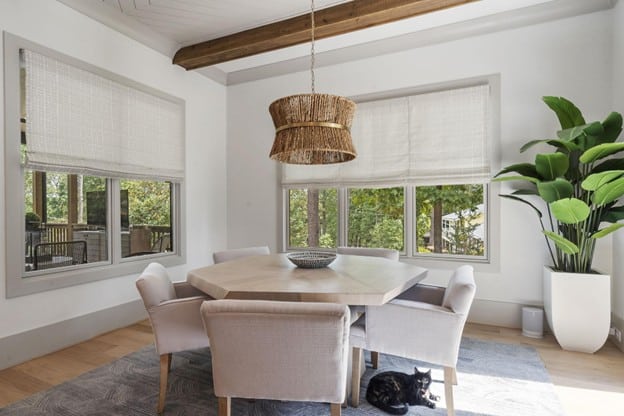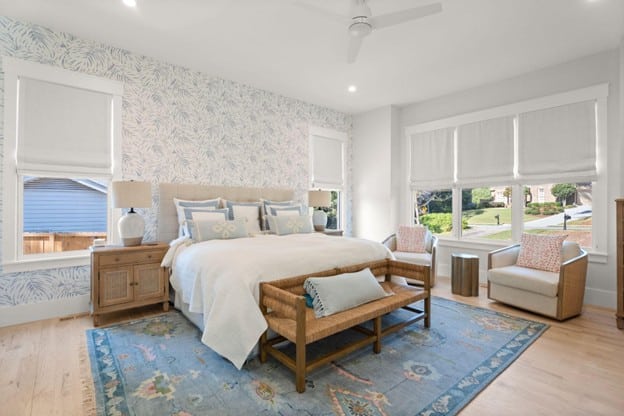When homeowners think about Roman shades, they usually picture soft folds, elegant fabrics, and timeless style. But here’s something you may not realize: Roman shades also offer real insulation benefits—making them both stylish and functional. So, are Roman shades good for insulation? The answer is yes—and here’s why.
How Roman Shades Help Insulate Your Home
Roman shades are fabric-based window coverings that create a barrier between the glass and your room. When properly installed, this layer helps reduce heat transfer, keeping your home more comfortable year-round. They trap air between the fabric and the window to form an insulating buffer, block cold drafts in winter, and minimize solar heat gain in summer. Adding a thicker lining, like blackout, boosts their performance even more.
Energy Efficiency Meets Everyday Comfort
Insulated Roman shades offer a range of benefits. They help lower your energy bills by stabilizing indoor temperatures, which means your HVAC system doesn’t have to work as hard. They also enhance comfort by reducing hot or cold spots near windows, making rooms feel more balanced throughout the day and across seasons. Many Roman shades can be lined to offer better control over both light and heat, and heavier fabrics or added linings can even dampen outside noise for a more peaceful home environment.
Understanding R-Values & Window Coverings
R-value is the measure of how well a material resists heat flow—the higher the number, the better the insulation. Windows themselves usually rate around R-2 (for a standard double-pane unit) [1]. Adding a window covering increases that effective R-value.
Here’s what research and industry bodies report:
- Roman Shades: DOE and PNNL note that Roman shades “offer some insulating value,” but no standardized R-value exists because performance varies widely with fabric, lining, and fit . Some trade sources estimate lined Roman shades may approach R-3 to R-4, but these are not verified through lab standards.
- Cellular Shades (Honeycomb): Tested in lab settings to measurably raise effective R-values, sometimes to R-4.5 or higher when side tracks are used.
- Heavy Drapery with Thermal Lining: Often cited at R-3 to R-4 depending on thickness and sealing.
Choosing the Right Fabric and Lining
The insulation performance of Roman shades depends heavily on the fabric and lining you choose. Blackout linings are the most effective option for insulation, as they block out light, reduce heat transfer in the summer, and help retain warmth during colder months.
These inside-mount blackout Roman shades in this customer’s bedroom block light and boost comfort—perfect for restful nights and quiet mornings.
On the other hand, privacy linings offer a lighter layer of protection. While they don’t block as much light or provide as much insulation as blackout linings, they still add a valuable buffer between your windows and your room. Privacy linings help soften incoming light, reduce glare, and provide a degree of thermal resistance—making them a great choice for living areas, dining rooms, or home offices where you want natural light but still desire improved comfort and privacy throughout the day.
In addition to your lining, the fabric itself plays a role. Tightly woven or heavier fabrics naturally insulate better than sheers or lightweight textiles. And for the best overall performance, an inside-mounted installation (Learn more about the differences b/t inside and outside mount shades) creates a snug fit within your window frame.
In this Atlanta customer’s home office, Roman shades with a heavier fabric help block heat and reduce glare—making the space cooler, more comfortable, and easier to work in throughout the day.
Where Roman Shades Work Best
Roman shades are ideal in spaces where you want both softness and performance. Bedrooms are a top pick, especially when paired with blackout linings for better sleep. Living rooms with large windows, home offices where glare is a concern, and dining or sitting rooms that receive strong afternoon sun are all great candidates for insulated Roman shades.
The Verdict: Yes, Roman Shades Help With Insulation
While Roman shades may not provide the same level of insulation as cellular shades, they still offer meaningful energy-saving benefits—especially when customized with the right materials and lining. For homeowners seeking a balance of beauty, comfort, and performance, Roman shades are a smart choice.
Referenced Content:
[1] https://www.energy.gov/energysaver/energy-efficient-window-coverings


